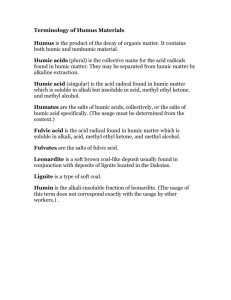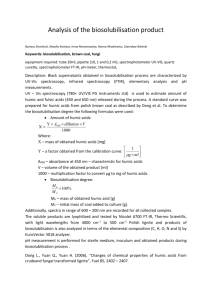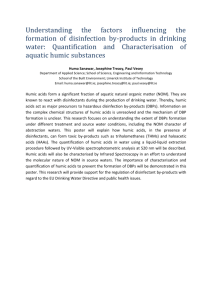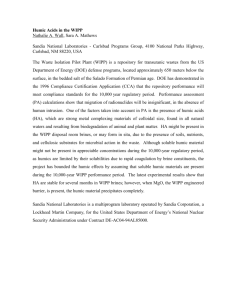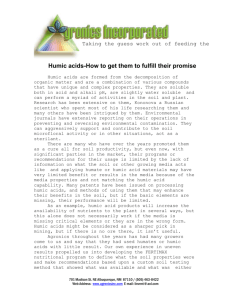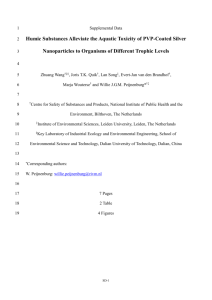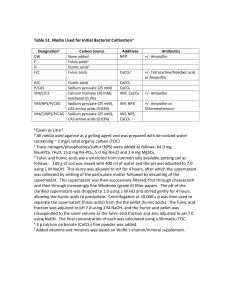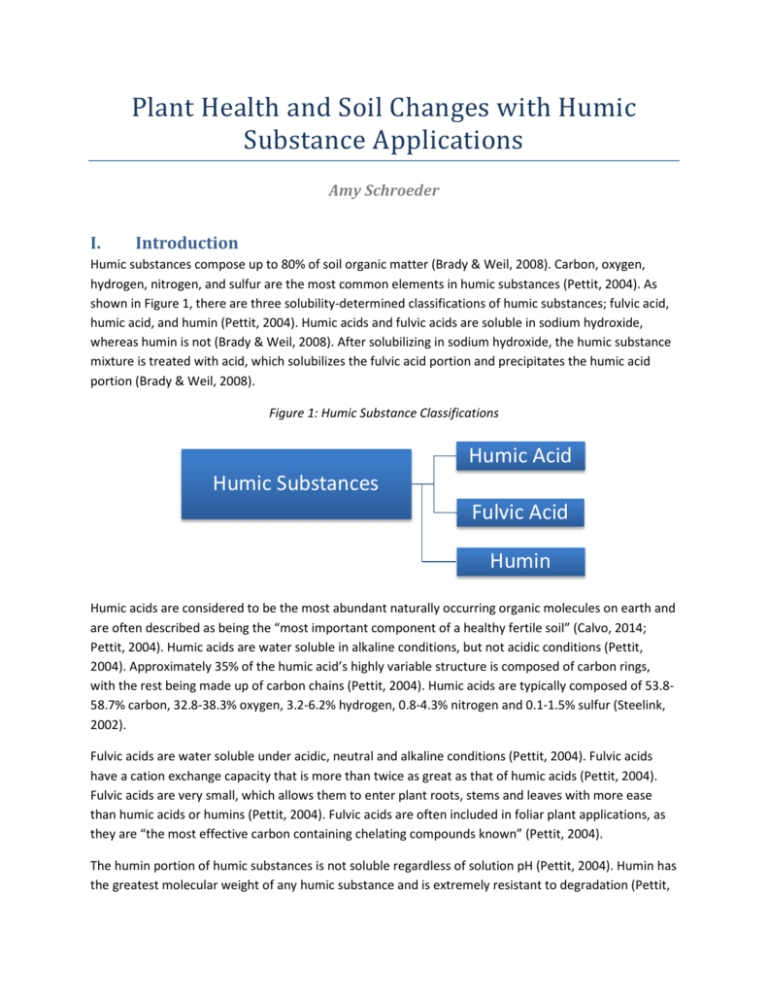
PlantHealthandSoilChangeswithHumic
SubstanceApplications
Amy Schroeder
I.
Introduction
Humic substances compose up to 80% of soil organic matter (Brady & Weil, 2008). Carbon, oxygen,
hydrogen, nitrogen, and sulfur are the most common elements in humic substances (Pettit, 2004). As
shown in Figure 1, there are three solubility-determined classifications of humic substances; fulvic acid,
humic acid, and humin (Pettit, 2004). Humic acids and fulvic acids are soluble in sodium hydroxide,
whereas humin is not (Brady & Weil, 2008). After solubilizing in sodium hydroxide, the humic substance
mixture is treated with acid, which solubilizes the fulvic acid portion and precipitates the humic acid
portion (Brady & Weil, 2008).
Figure 1: Humic Substance Classifications
Humic Acid
Humic Substances
Fulvic Acid
Humin
Humic acids are considered to be the most abundant naturally occurring organic molecules on earth and
are often described as being the “most important component of a healthy fertile soil” (Calvo, 2014;
Pettit, 2004). Humic acids are water soluble in alkaline conditions, but not acidic conditions (Pettit,
2004). Approximately 35% of the humic acid’s highly variable structure is composed of carbon rings,
with the rest being made up of carbon chains (Pettit, 2004). Humic acids are typically composed of 53.858.7% carbon, 32.8-38.3% oxygen, 3.2-6.2% hydrogen, 0.8-4.3% nitrogen and 0.1-1.5% sulfur (Steelink,
2002).
Fulvic acids are water soluble under acidic, neutral and alkaline conditions (Pettit, 2004). Fulvic acids
have a cation exchange capacity that is more than twice as great as that of humic acids (Pettit, 2004).
Fulvic acids are very small, which allows them to enter plant roots, stems and leaves with more ease
than humic acids or humins (Pettit, 2004). Fulvic acids are often included in foliar plant applications, as
they are “the most effective carbon containing chelating compounds known” (Pettit, 2004).
The humin portion of humic substances is not soluble regardless of solution pH (Pettit, 2004). Humin has
the greatest molecular weight of any humic substance and is extremely resistant to degradation (Pettit,
2004). The presence of humin in the soil improves the soil’s water holding capacity, structure, and
fertility, among other functions (Pettit, 2004).
Commercially available humic substances are extracted from composts, coal and peat (Quilty, 2011).
They are available in liquid and granular forms. Liquid humic substances are applied to the soil or to the
plant’s foliage (Quilty, 2011). Granular humic substances are applied to the soil’s surface or incorporated
into the soil (Quilty, 2011). Suggested application rates for liquids range from 0.4-12 L per acre (Quilty,
2011). Suggested granular application rates range from 22-357 pounds per acre (Quilty, 2011).
II.
Impact on Plant Growth
A.
Nutrient Uptake
Laboratory studies indicate that the presence of humic substances may increase the uptake of nutrients;
however, success in field studies is sporadic. The extent of impact on nutrient uptake may be related to
the molecular size of the humic substance applied, in addition to other factors. A study conducted in
1992 observed that the application of humic substances with the smallest molecular size resulted in the
greatest effect on plant nitrate uptake (Calvo, 2014). Humic acid molecules are small, which “allows
them to reach the plant plasma membrane, where they effectively influence the assimilation of
nutrients” (Quilty, 2011).
In a study conducted in 1998, humic acids were extracted from two commercial products that were
prepared from peat and leonardite sources, labeled CP-A and CP-B, respectively (Adani, 1998). Upon the
addition of humic acids from peat and leonardite sources to hydroponic solutions, tomato plants’ uptake
of nitrogen, phosphorus, and iron increased (Adani, 1998). In a greenhouse study conducted on
strawberry plants grown in calcareous soil, the application of humic acid in solid and liquid forms did not
significantly impact the nutrient content of the plants (Pilanali, 2003). Foliar application of 0.1% and
0.2% humic acid solutions to maize grown in calcareous soils resulted in a statistically significant impact
on the uptake of copper, zinc, and manganese (Çelik, 2010). During a field study in which phosphorus
and humic acid were applied to lettuce, the nitrogen content of the leaves increased (Cimrin, 2005).
After application of humic acid, increased uptake of nitrogen, phosphorus, potassium, calcium, and
magnesium was observed in peppers and cucumbers (Calvo, 2014). Increased uptake of nitrate was
observed in beans, wheat and cucumbers after the application of humic acid (Calvo, 2014).
B.
Total Plant Biomass
In a study conducted in 2006, humic acids extracted from vermicompost were added to planting
medium at rates ranging from 250 to 1000 mg/kg (Arancon, 2006). “As a general pattern, plant growth
increased in response to treatments of the plants with 50-500 mg/kg humic acids, but decreased
significantly when the concentrations of humic acids in the container medium exceeded 500-1000
mg/kg” (Arancon, 2006). In a field study conducted on cucumbers, increased plant growth and fruit yield
was observed when humic acid was applied (Calvo, 2014).
C.
Root and Shoot Growth
As early as 1950, positive impacts from the addition of humic acids have been observed with regard to
root growth (Cooper, 1998). When 4-5 mg/L humic acid was added to the solution in which corn was
grown, the root length and number doubled, as compared to corn grown in a solution without humic
acid (Cooper, 1998). A study conducted in 2008 attributed increased root elongation in germinating
maize seed to “interaction between plant hormones and a humic substance treatment” (Quilty, 2011).
In a study conducted in 1998, humic acids were extracted from two commercial products that were
prepared from peat and leonardite sources, labeled CP-A and CP-B, respectively (Adani, 1998). Tomato
plants treated with CP-A (from peat) had statistically significant increases in root growth, as compared
to the control (Adani, 1998). Tomato plants treated with CP-B (from leonardite) had statistically
significant increases in root and shoot growth, as compared to the control (Adani, 1998). In this study,
root growth was more significantly impacted than shoot growth (Adani, 1998). Other studies have
observed increases in shoot growth of cucumber, wheat, maize, and pepper (Calvo, 2014).
In a study conducted in 2006, humic acids extracted from vermicompost were added to planting
medium at rates ranging from 250 to 1000 mg/kg (Arancon, 2006). A statistically significant increase in
the dry weight of roots of marigolds and peppers grown in the planting medium resulted (Arancon,
2006). In other studies, humic acids extracted from vermicompost increased root growth in banana,
strawberry and cowpea plants (Quilty, 2011).
The application of humic substances to creeping bentgrass resulted in an average of 26% increase in
root mass in the top 10 cm, as compared to the untreated control (Cooper, 1998). Root masses also
increased at depths greater than 20 cm when humic substances were applied, as compared to the
untreated control (Cooper, 1998). The application of granular humic substances resulted in a greater
maximum root length, as compared to the untreated control (Cooper, 1998). Greater root mass resulted
when granular humate was incorporated into the growing medium, as opposed to when it was applied
to foliage (Cooper, 1998). This “may have been a result of granular humate and its breakdown products
being in more direct contact with roots compared with humic acid treatments that were applied to
foliage” (Cooper, 1998).
D.
Fruit Growth
In a study conducted in 2006, humic acids extracted from vermicompost were added to planting
medium at rates ranging from 250 to 1000 mg/kg (Arancon, 2006). A statistically significant increase in
the fruit weights of tomatoes grown in the planting medium was observed (Arancon, 2006). A
statistically significant increase in the number of fruits of strawberries and peppers grown in the
planting medium was also observed (Arancon, 2006). The number of flowers and fruits observed in
peppers grown in the humic acid supplemented planting medium did not differ significantly from
peppers grown in a planting medium supplemented with a plant growth regulator, which led the
researchers to believe that “humic acid had a similar effect on pepper plants similar to the effects of a
plant growth regulator” (Arancon, 2006). In a greenhouse study during which peppers were treated with
soil and foliar humic acid applications, fruit firmness, fruit length, and fruit diameter were not
significantly effected (Karakurt, 2009). A significant increase in mean fruit weight, sugar content and
yield of peppers was observed after soil and foliar humic acid applications (Karakurt, 2009). In a
greenhouse study in which humic acid was applied in addition to the recommended fertilizer regime, the
number of fruits per okra plant significantly increased (Calvo, 2014). When the recommended fertilizer
regime was decreased by 50% and humic acid was applied, there was not a significant increase in
number of fruits per okra plant (Calvo, 2014).
III.
Impact on Soil Characteristics
The addition of humic substances to soils can have important implications on the soil physical, chemical,
and biological characteristics. The addition of organic matter, such as humic substances, increases soil
aggregation, water retention, infiltration rate, and water-holding capacity (Brady & Weil, 2008).
“Addition of humic substances has been shown to improve aggregation in soils with a range of texture
grades and mineral suites” (Quilty, 2011). The impact on aggregation appears to vary by the source of
the humic substances applied. When sandy and clay soils were treated with a peat-extracted humic
substance, the number of small aggregates (<1000mm) increased (Quilty, 2011). When sandy and clay
soils were treated with a manure-extracted humic substance, the number of large aggregates (1500–
2500mm) increased (Quilty, 2011). Aggregation promotes high infiltration rates, which reduce runoff
and erosion (Sylvia, 1998). The cation exchange capacity of the soil is also impacted by the application of
humic substances. “Humus generally accounts for 50 to 90% of the cation-absorbing power of mineral
surface soils. Like clays, humus colloids hold nutrient cations (potassium, calcium, magnesium, etc.) in
easily exchangeable form, wherein they can be used by plants but are not too readily leached out of the
profile by percolating waters” (Brady & Weil, 2008). From a biological perspective, humic substances
enhance soil fertility by impacting the composition of microbial populations (Calvo, 2014).
The efficacy of humic substances is related to how similar the applied substances are to the humic
substances in the native soil, which is impacted by the origin of the material and the processing methods
(Senesi, 2007). “Since soil {humic substances] contribute essential functions to global soil fertility and
health, the greater the amount and the more the compositional, structural and functional properties of
[humic substance]-like fractions resemble those of native soil [humic substances], the more
agronomically efficient, environmentally safe and economically valuable is the organic amendment”
(Senesi, 2007). Processed humic substances typically have higher carbon, hydrogen, nitrogen and sulfur
contents when compared to humic substances found in native soil (Senesi, 2007). When humic
substances originating from the composting of municipal solid waste, sewage sludge, livestock waste,
and food production waste were applied to various soil types, their molecular properties tended to
change over time to more closely match the molecular properties of the humic substances found in the
native soil (Senesi, 2007).
Just as the impact of humic substances varies by the source of the humic substance, plant species, and
application method, it also varies by the type of soil (Seyedbagheri, 2010). In an experiment conducted
in Saylor Creek, Idaho, several rates of humic acid were applied to plots in a randomized complete block.
A 6% humic acid solution was applied at rates of 3, 7, 15, 30 and 60 L/humic acid/acre (Seyedbagheri,
2010). The plots were located in three different farmers’ fields. The fields had calcareous soils (pH 8-8.2)
and an organic matter content of approximately 1%. Potatoes were planted in plots and humic acid was
applied via side dressing on both sides of the rows (Seyedbagheri, 2010). Stand and vigor increased in
plots treated with humic acid, as compared to the control plots (Seyedbagheri, 2010). Potato yields
increased with increasing rates of humic acid application up to 30 L/humic acid/acre, but were reduced
at the highest treatment of 60 L/humic acid/acre (Seyedbagheri, 2010). The impacts on yield could be
due to the effects of humic acid on the reactions that form organic-clay complexes (Seyedbagheri,
2010). “This reaction contributes to the creation of stable humus, which impacts soil physical, chemical
and biological functions” (Seyedbagheri, 2010).
When Seyedbagheri applied granular and liquid humic acid to plots with calcareous silt clay loam soil,
there was no statistical difference in yield between humic acid treatments and the control
(Seyedbagheri, 2010). Granular humate was applied via top dressing at a rate of 16 kg per acre and
liquid humate was applied via side dressing at the rates of 0, 18, and 37 L/humic acid/acre
(Seyedbagheri, 2010).
IV.
Conclusion
Based on laboratory experiments, humic substances show promise for commercial crop production;
however, the extent of positive crop response is difficult to predict. To date, field research has shown
mixed results. Humic substances may have an impact on plant growth and soil characteristics; however,
the magnitude of the impact is determined by several factors, which include the source of the humic
substance, plant species, method of application, and soil type. The efficacy of humic substances is also
related to how similar the applied substances are to the humic substances in the native soil, which is
impacted by the origin of the material and the processing methods (Senesi, 2007). With further field
research, we will develop a greater understanding of how applied humic substances impact the plant
and soil, which will allow us to more effectively integrate humic substances into fertilizer application
regimes.
V.
References
Adani, F., Genevini, P., Zaccheo, P., and G. Zocchi. 1998. The Effect of Commercial Humic Acid on Tomato
Plant Growth and Mineral Nutrition. Journal of Plant Nutrition. 21 (3): 561-75.
Arancon, N.Q., Edwards, C.A., Lee, S., and R. Byrne. 2006. Effects of Humic Acids from Vermicomposts on
Plant Growth. European Journal of Soil Biology. 42 (1): S65-S69.
Brady, N.C., and R.R. Weil. 2008. The Nature and Properties of Soils. Pearson Prentice Hall, Upper Saddle
River, NJ.
Calvo, P., Nelson, L., and J.W. Kloepper. 2014. Agricultural Uses of Plant Biostimulants. Plant and Soil.
383 (1): 3-41.
Çelik H., Katkat, A.V., Aşık, B.B., and M.A. Turan. 2010. Effect of Foliar-Applied Humic Acid to Dry Weight
and Mineral Nutrient Uptake of Maize under Calcareous Soil Conditions. Communications in Soil
Science and Plant Analysis. 42 (1): 29-38.
Cimrin, K.M., and I. Yilmaz. 2005. Humic Acid Applications to Lettuce Do Not Improve Yield but Do
Improve Phosphorus Availability. Acta Agriculturae Scandinavica. 55 (1): 58-63.
Cooper, R. J., Liu, C., and D.S. Fisher. 1998. Influence of Humic Substances on Rooting and Nutrient
Content of Creeping Bentgrass. Crop Science. 38 (6): 1639-1644.
Karakurt, Y., Unlu, H., Unlu, H., and H. Padem. 2009. The Influence of Foliar and Soil Fertilization of
Humic Acid on Yield and Quality of Pepper. Acta Agriculturae Scandinavica. 59 (3): 233-237.
Kaschl, A., and Y. Chen. 2005. Interactions of Humic Substances with Trace Metals and their Stimulatory
Effects on Plant Growth. Use of Humic Substances to Remediate Polluted Environments: From
Theory to Practice. Springer Netherlands.
Pettit, R.E. 2004. Organic Matter, Humus, Humate, Humic Acid, Fulvic Acid and Humin: Their Importance
in Soil Fertility and Plant Health [Online]. Available at
http://fertiorganicos.com/english/images/lib/ORGANIC_MATTER_HUMUS_HUMATE_HUMIC_ACID
_FULVIC_ACID.pdf CTI Research. 1-15.
Pilanali, N and M. Kaplan. 2003. Investigation of Effects on Nutrient Uptake of Humic Acid Applications
of Different Forms to Strawberry Plant. Journal of Plant Nutrition. 26 (4): 835-843.
Quilty, J., and S. Cattle. 2011. Use and Understanding of Organic Amendments in Australian Agriculture:
A Review. Soil Research. 49 (1): 1-26.
Senesi, N., Plaza, C., Brunetti, G., and A. Polo. 2007. A Comparative Survey of Recent Results on Humiclike Fractions in Organic Amendments and Effects on Native Soil Humic Substances. Soil Biology &
Biochemistry. 39 (6): 1244-1262.
Seyedbagheri, M. 2010. Influence of Humic Products on Soil Health and Potato Production. Potato
Research. 53 (4): 341-349.
Steelink, C. 2002. Investigating Humic Acids in Soils. Analytical Chemistry. 74 (11): 326A-333A.
Sylvia, D.M., Hartel, P.G., Fuhrmann, J.J. and D.A. Zuberer. 1998. Principles and Applications of Soil
Microbiology. Prentice Hall, Upper Saddle River, NJ.

